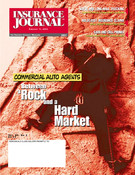Thinking of forming an agency captive?
An agent-owned captive insurance company involves an agency capitalizing either a domestic insurance company or an offshore insurance company. Richard Turner, president of Pennsylvania-based Commonwealth Risk Services, said agency captives and agency rent-a-captives have recently attracted significant attention from interested individuals—and the time to jump in is now.
“The market has gotten extremely hard in the last year or so, and one of the popular things the last couple of years has been agency captives and agency rent-a-captives,” Turner said. He added that contrary to the idea that the time to set up an agency captive and participate in underwriting profit is when the market is good, numerous agency captives and rent-a-captives were set up during the soft market.
“Market timing for agency captives right now is a good alternative to come up with,” Turner said. “The problem is there are fewer markets in terms of reinsurers, and running companies and policy issuance companies willing to jump into the fray.”
Philip J. Stevens, ARM, senior vice president, AonIRMG, asserted that, for the next two years, the timing will be good for agents interested in forming captives.
“Things will probably soften up come 2004,” Stevens said. “For profitable captives, the normal rate increases would be felt from the reinsurers as a result of Sept. 11. Fronting fees have gone up quite a bit. Fees that used to be five or six percent are now seven to eight percent as the norm. Reinsurance is always dicey. It used to be easier to put together an agency rent-a-captive program. The carriers who used to be in there for pure fronting and with 100 percent reinsurance have been greatly affected by Sept. 11. It is very difficult to put together a pure funded program with 100 percent reinsurance.”
According to California insurance and reinsurance consultant Andy Barile, the decision to turn to a captive for many agents is motivated by a desire to create added profit. Barile noted that agents looking at creating additional profits in their structures are starting to ask the basic questions—one of which is whether the agent should capitalize another entity and become a risk taker.
Barile said the key question agents need to address is if they have enough resources to initiate such an undertaking.
“If you’re a salesperson, you’ve got to balance the sales ability…with the underwriting ability of your structure,” Barile commented. And the more expertise agents have in a specific product, the better. “If you become a specialist and have a specialty program, you then know all the components to become successful,” Barile said.
Stevens agreed that having a niche is helpful to forming a captive.
“Start-ups in this market are getting to be very difficult,” Stevens said. “An agent who is specialized in whatever class it may be, and who can evidence to an underwriter that he brings some special value added to that class of business the normal general agent does not, will be more successful in finding new fronts and reinsurers.”
However, Barile pointed out that in examining the carriers for the program business, an agent must realize the fact that some existing programs have been downgraded, and their security is now suspect in some cases. “Now you have to think about moving programs, prices going up, companies being merged out of business,” Barile said. “An agency captive has no baggage, no losses from prior underwriting like some of the big carriers.”
Stevens commented that as the market continues to harden, and some insurance companies are cutting back on profit sharing with their agents, an agency rent-a-captive could be an alternative to cut backs and profit sharing. “A lot of the agents have seen the opportunities,” he said. “If they’d put their preferred business into a program, such as an agency rent-a-captive, they can capture the underwriting profits, which in some cases can be much larger than a normal profit sharing mechanism.”
If the advantages to starting an agency captive include capturing underwriting profit and investment income the insurance company would otherwise be capturing, Stevens noted that at least one disadvantage is that the agent will not get his money out for a long period of time.
“There are a lot of people who are selling agency rent-a-captives who would like to suggest to agents that they’ll be seeing dividends within three years,” Stevens continued. “On a casualty book of business, that’s not the case. It is usually the fifth, sixth or seventh year that the agent will get his money out. They have to have the commitment and also see the program through. The more profitable it is, the more control the agent will have in working with his underwriters to stabilize the rates.”
According to Stevens, if the agent already has a profitable book of business, then now would be a great time to act since rates will go up and losses will stay flat.
“In theory, there should be more underwriting profits in the years ahead,” Stevens commented. “For an agent trying to capitalize on distress books of business because the premiums are going up so much—and he’s getting myopic in terms of potential commission—this is probably not a good starting point for an agency captive. Books to get involved in are those that are low hazard, while they should stay away from PEOs, nursing homes and the truckers.”
But to get in at this juncture, an agent needs to come up with a significant amount of capital.
Turner noted that with a number of the agency captives, a way to limit the losses an agency might sustain on a program can be achieved through reinsurance or by the policy-issuing carrier providing an aggregate stop loss, which limits participation on the part of the captive. “Captive agents need to wait until losses play out,” he said. “Each year you’ll have to come up with a fair amount of capital. If you’re standing back as an agent looking at the industry, you’d ask, ‘Is the cost of insurance for my clients significantly higher than it has been in other years?'”
A main aspect to understand is what markets are doing agency captives, and if they are going to do it, how much capital will be needed in order to put the deal together.
Turner agreed with Stevens that there are several pitfalls to avoid.
“One of the areas to stay away from are PEOs. Very difficult class for a number of reasons, including poor financials, can change its profile overnight, etc.,” Turner said. “If you’re going to have an agency captive, concentrate on business you write, make sure it is a low-hazard, and you feel comfortable with the loss ratio you’ve had. One of the theories is do you want a heterogeneous captive or a homogeneous captive?
“Heterogeneous would be a classic business like workers’ comp, where you have a whole variety of different risks you can minimize by having certain class codes that fit in,” Turner continued. “Homogeneous would be one where you are well suited and can get a decent book of business, one [class] of business, and you obviously know it. Problem is, can you get the premium level you want?”
In addition, Turner believes that one thing that needs to change in the wake of 9/11 is that statutory excess costs have gone up tremendously.
“I expect fronting fees to continue going up for now,” Turner commented. “What will be interesting to see is what happens with the new capital that has come into the market since 9/11. Not a lot of it has been employed yet. We’ll see where it finds itself, which will have some impact on the cost of reinsurance and other things. It is a little too early to see how that will be used.”
Topics Carriers Agencies Profit Loss Underwriting Reinsurance
Was this article valuable?
Here are more articles you may enjoy.


 Twice Injured Firefighter Loses Second Workers’ Compensation Claim
Twice Injured Firefighter Loses Second Workers’ Compensation Claim  Massachusetts Approves Reorganizations, Mergers for Andover Companies
Massachusetts Approves Reorganizations, Mergers for Andover Companies  CEO Sentenced in Miami to 15 Years in One of the Largest Health Care Fraud Cases
CEO Sentenced in Miami to 15 Years in One of the Largest Health Care Fraud Cases  UPS Ripped Off Seasonal Workers With Unfair Pay Practices, Lawsuit Alleges
UPS Ripped Off Seasonal Workers With Unfair Pay Practices, Lawsuit Alleges 


